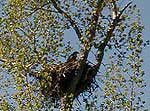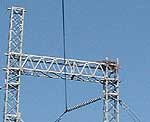By Dan Gunderson
Minnesota Public Radio
July 4, 2002
A Minnesota research project may help get the bald eagle off the endangered species list. Any state with an eagle population needs a plan to monitor and protect the birds. Learning where eagles nest may help protect the habitat they need to flourish.
| |
|
|
|
||
Jim Grier knows eagles. He's watched the birds and climbed into their nests for 44 years. The North Dakota State University zoology professor is leading a study of Minnesota eagle habitat.
His research starts in early spring. Grier spends hours flying with a Dpilot from the Department of Natural Resources, looking for eagle nests. When he spots one that appears to be an active nesting site, he marks its location on a map.
There are more than 700 bald eagle pairs in Minnesota. After the nests are located and mapped, the hard work starts.
Graduate student Jeremy Guinn spends weeks driving, hiking and canoeing to eagle nests. He typically gets to two or three a day. As he approaches a nest, he peers through binoculars looking for signs of life.
A young eagle looks down from a nest high atop a cottonwood tree in a farmer's pasture. The adult eagles are likely fishing in a nearby lake. Guinn conducts a detailed study of the area around the nest.
Guinn says the study includes, "what kind of trees they use, what kind of forest they choose to place their nest in, how close to the water they are, and also to determine the amount of human activity they choose to nest around."
| |
|
|
|
||
Eagles are more often choosing humans for neighbors. Because eagle populations are growing so quickly, traditional forest nesting areas like the Chippewa National Forest in northern Minnesota are crowded. Each pair of eagles needs its own territory, so young pairs are often forced to look for less traditional nesting sites.
"I've seen eagles on power lines, in the back yard of a cabin, some even overlooking the cabin - where the nest is over the roof of a cabin," says Guinn.
It appears bald eagles are quite adaptable. They need a tall tree where they can build a nest, and water nearby where they can catch fish. But one of the key questions is how well they tolerate human neighbors.
North Dakota State University eagle researcher Jim Grier says each new generation of eagles seems a bit more tolerant.
"A lot of the eagle nests now that are in close contact with human activity - the young birds that grow up in those nests - looking down and seeing all the human presence around them," says Grier. "As long as people aren't shooting at them or bothering them, as long as everybody is minding their own business, the eagles basically accept humans are part of the natural environment."
The study Jim Grier is doing should provide a better understanding of how to make sure eagle nesting sites are protected.
| |
|
|
|
||
States must develop a management plan that meets two challenges before the bald eagle is taken off the endangered list. The plans must include steps to monitor eagle populations in the future, and others to protect the eagles' nesting habitat.
But monitoring eagles is labor-intensive and expensive. Eagle researchers say a more efficient way of checking on the birds is needed. Some say enlisting volunteers to monitor nests may be one answer. But there are questions about the scientific validity of that method.
Researcher Jim Grier says it may be two or three years before everyone can agree on a plan to protect eagles in the future.
Minnesota DNR non-game specialist Joan Galli says she's not predicting when the bald eagle will come off the endangered species list.
"This is a species where the recovery is good and the news is good and things are going well, and you would think it would be easy to delist," says Galli. "That is not the case - it's been quite a challenge."
The study of bald eagle habitat in Minnesota should be completed later this year. The DNR and the U.S. Fish and Wildlife Service will use the results to develop a more comprehensive plan for managing the bald eagle.
More Information


